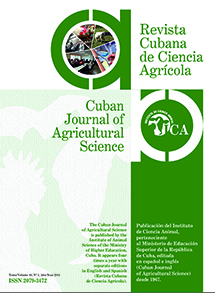Voluntary intake and ruminal pH as fermentation indicators in sheep fed a lactic probiotic
Contenido principal del artículo
Resumen
To evaluate the effect of a lactic probiotic on voluntary intake and pH performance in sheep, four Pelibuey animals were used, distributed in a Latin square design (4x4). With an average live weight of 20.75 ± 0.84 kg, they were housed in individual metabolism cages for four periods, 15 days each (10 for adaptation and 5 for sampling), for a total of 60 days. Treatments consisted of the increasing addition (15, 25 and 35 g day-1) of a lactic probiotic to the supplement offered (5 g kg LW-1) on a single occasion during the day (08:30 am), followed by the supply of forage at will. It was demonstrated that dry matter voluntary intake, both absolute (1.16 vs. 1.14 kg, P=0.0011) and relative to metabolic weight (120.37
vs. 118.40 g kg LW 0.75, P=0.0008), benefited the treatment with 15 g d-1 of participation of the probiotic in the diet and control, respectively. Mean ruminal pH values were 6.49 ± 0.18 and showed fluctuations between 6 and 20 h after the initial food ingestion. It is concluded that the minimum level (15 g day-1) of the lactic probiotic in the diet did not affect nutrient intake with respect to control, although superior levels decreased it. This minimum level maintained the ruminal pH, with variations during the frequency of feed administration.
Key words: lactic acid bacteria, rumen, Pelibuey sheep
vs. 118.40 g kg LW 0.75, P=0.0008), benefited the treatment with 15 g d-1 of participation of the probiotic in the diet and control, respectively. Mean ruminal pH values were 6.49 ± 0.18 and showed fluctuations between 6 and 20 h after the initial food ingestion. It is concluded that the minimum level (15 g day-1) of the lactic probiotic in the diet did not affect nutrient intake with respect to control, although superior levels decreased it. This minimum level maintained the ruminal pH, with variations during the frequency of feed administration.
Key words: lactic acid bacteria, rumen, Pelibuey sheep
Detalles del artículo
Cómo citar
Gutiérrez, D., & Borroto, H. (2020). Voluntary intake and ruminal pH as fermentation indicators in sheep fed a lactic probiotic. Cuban Journal of Agricultural Science, 54(4). Recuperado a partir de https://mail.cjascience.com/index.php/CJAS/article/view/990
Sección
Ciencia Animal
Aquellos autores/as que tengan publicaciones con esta revista, aceptan los términos siguientes:
- Los autores/as conservarán sus derechos de autor y garantizarán a la revista el derecho de primera publicación de su obra, el cuál estará simultáneamente sujeto a la Licencia Creative Commons Attribution-NonCommercial 4.0 International (CC BY-NC 4.0) que permite a terceros compartir la obra siempre que se indique su autor y su primera publicación esta revista. Bajo esta licencia el autor será libre de:
- Compartir — copiar y redistribuir el material en cualquier medio o formato
- Adaptar — remezclar, transformar y crear a partir del material
- El licenciador no puede revocar estas libertades mientras cumpla con los términos de la licencia
Bajo las siguientes condiciones:
- Reconocimiento — Debe reconocer adecuadamente la autoría, proporcionar un enlace a la licencia e indicar si se han realizado cambios. Puede hacerlo de cualquier manera razonable, pero no de una manera que sugiera que tiene el apoyo del licenciador o lo recibe por el uso que hace.
- NoComercial — No puede utilizar el material para una finalidad comercial.
- No hay restricciones adicionales — No puede aplicar términos legales o medidas tecnológicas que legalmente restrinjan realizar aquello que la licencia permite.
- Los autores/as podrán adoptar otros acuerdos de licencia no exclusiva de distribución de la versión de la obra publicada (p. ej.: depositarla en un archivo telemático institucional o publicarla en un volumen monográfico) siempre que se indique la publicación inicial en esta revista.
- Se permite y recomienda a los autores/as difundir su obra a través de Internet (p. ej.: en archivos telemáticos institucionales o en su página web) antes y durante el proceso de envío, lo cual puede producir intercambios interesantes y aumentar las citas de la obra publicada. (Véase El efecto del acceso abierto).
